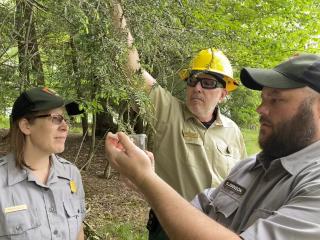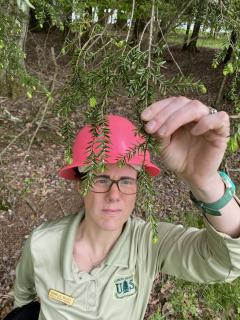Biocontrol agent protects “witness grove” at Flight 93 National Memorial
PENNSYLVANIA—USDA Forest Service State, Private, and Tribal Forestry staff worked with the National Park Service to protect eastern hemlock trees against an invasive insect in the “witness grove” at the Flight 93 National Memorial, which commemorates lives lost in southwestern Pennsylvania on 9/11.
Today, this grove of hemlock is threatened by an infestation of hemlock woolly adelgid, an insect that kills hemlock by feeding on needle sap and robbing the trees of nutrients. The needles turn gray and die, leaving the tree itself to starve to death within three to five years.
In May, the Forest Service and National Park Service introduced silver flies at the Flight 93 memorial as a biocontrol agent against HWA. At their larval stage, silver flies feed on HWA eggs, reducing their population on host hemlock trees and providing the trees with a greater chance of long-term survival.
Virginia Tech provided the 630 silver flies, comprised of two species, Leucotaraxis piniperda and Leucotaraxis argenticollis. Before releasing them, State, Private, and Tribal Forestry staff searched the witness grove for a suitable site where hemlock trees were still living and had an appropriate level of HWA infestation.
The silver flies were shipped overnight from Virginia Tech in six vials. Each vial was carefully opened and held beneath HWA-infested branches as the flies moved onto the foliage. Most of the flies left the vial almost immediately, but a few had to be coaxed out with a hemlock branch inserted in the vial for them to fly or crawl onto.
This is the second release of a biocontrol agent against HWA at the Flight 93 National Memorial, where the Forest Service has worked in collaboration with the National Park Service since 2012 to protect the hemlock trees. A species of predatory beetles, Laricobius nigrinus, was released at the site a few years ago.

Hemlock trees are an ecologically critical species because of the dense shade they create. This shade maintains the cold stream temperatures required for native trout and other aquatic life, as well as habitat for many native plants.
“With the release of silver flies in conjunction with the predatory beetles released the other year, we anticipate that they will keep HWA levels in check so the hemlock trees will continue to thrive for years to come,” said Danielle Kelley, a forest health technician with the Forest Service Eastern Region’s State, Private, and Tribal Forestry. “The release of biocontrol agents is a crucial step in the Integrated Pest Management strategy. It will reduce chemical intervention, and in the future biocontrol agents may allow eastern hemlocks to persist in the natural landscape unaided.”
The Forest Service will continue its shared commitment of hemlock preservation with the National Park Service by protecting hemlock trees within the ‘witness grove’ as a vital component of the Flight 93 National Memorial.

